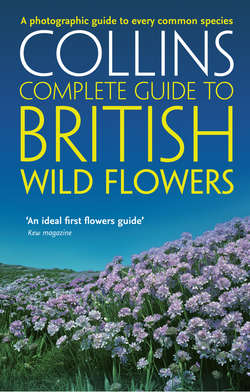Читать книгу British Wild Flowers: A photographic guide to every common species - Paul Sterry - Страница 6
ОглавлениеHOW TO USE THIS BOOK
THE BOOK HAS BEEN designed so that the text and photographs for each species are on facing pages. A system of labelling clearly states the flower’s identity. The text has been written to complement the information conveyed by the photographs. By and large, the order in which the species appear in the main section of the book roughly follows standard botanical classification. However, because parts of the field are in a state of flux, the order may differ slightly from that found in other guides, past, present or future.
SPECIES DESCRIPTIONS
At the start of each species description the plant’s most commonly used and current English name is given. This is followed by the scientific name, comprising the genus name first and then by the specific name. In a few instances, where this is pertinent, reference is made, in either the species heading or the main body of the text, to a further subdivision: subspecies. In general, I have followed the nomenclature of Clive Stace’s New Flora of the British Isles (see p.). However, with orchids I have used the most up-to-date classification system, which differs from that in most currently available floras. The family group to which the plant in question belongs is then given. If a species is anything other than widespread and common, there then follows a measure of its scarcity, indicated by rosette symbols:
| Scarce overall, but locally common | |
| Scarce, local and seldom common | |
| Local and rare |
These scarcity ratings are based on my own observations, so they are subjective and are not intended as an absolute guide to a species’ status. Lastly in the heading, some measure is given of the plant’s size. Size and stature vary according to a number of factors so these values should be treated with a degree of caution.
The text has been written in as concise a manner as possible. Each description begins with a summary of the plant and the habitat that it favours. To avoid potential ambiguities, the following headings break up the rest of each description: FLOWERS; FRUITS; LEAVES; STATUS. These sections describe the colour, shape and size of the various plant parts – features that tend to be more constant, and hence more useful for identification, than the overall size of the plant. Text in italics relates to key features of identification.
MAPS
The maps provide invaluable information about the distribution and occurrence of each species in the region: the intensity of the colour gives an indication of abundance. In compiling the maps, I have made reference to a number of sources, including An Atlas of the Wild Flowers of Britain and Northern Europe, the New Atlas of the British and Irish Flora (see p.), various county floras and, of course, my own notes. The maps represent the current ranges of plants in the region in general terms. Please bear in mind that, given the size of the maps, small and isolated populations will not necessarily be featured. Note also that the ranges of many species (particularly those influenced by agriculture) are likely to contract further as the years go by.
PHOTOGRAPHS
Great care has gone into the selection of photographs for this book and in many cases the images have been taken specifically for this project. Preference has been given to photographs that serve both to illustrate key identification features of a species when in flower, and to emphasise its beauty. In many instances, smaller inset photographs illustrate useful identification features that are not shown clearly by the main image.
